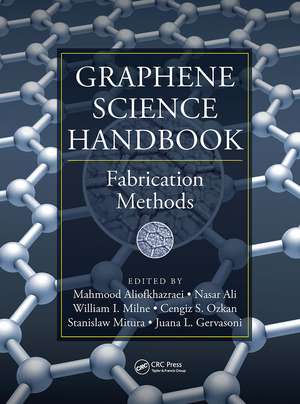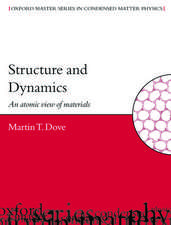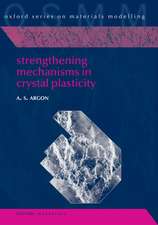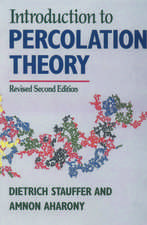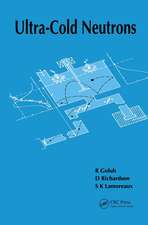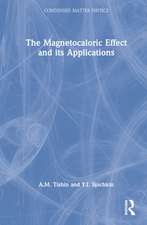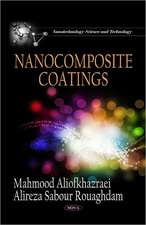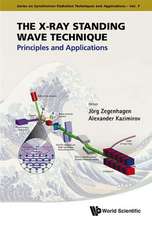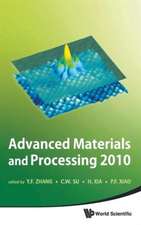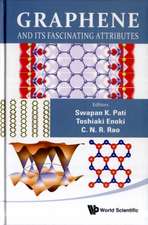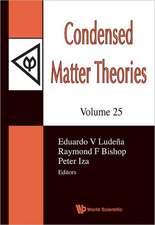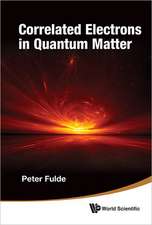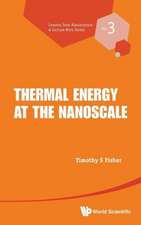Graphene Science Handbook: Fabrication Methods
Editat de Mahmood Aliofkhazraei, Nasar Ali, William I. Milne, Cengiz S. Ozkan, Stanislaw Mitura, Juana L. Gervasonien Limba Engleză Hardback – 25 apr 2016
The Graphene Science Handbook is a six-volume set that describes graphene’s special structural, electrical, and chemical properties. The book considers how these properties can be used in different applications (including the development of batteries, fuel cells, photovoltaic cells, and supercapacitors based on graphene) and produced on a massive and global scale.
Volume One: Fabrication Methods
Volume Two: Nanostructure and Atomic Arrangement
Volume Three: Electrical and Optical Properties
Volume Four: Mechanical and Chemical Properties
Volume Five: Size-Dependent Properties
Volume Six: Applications and Industrialization
This handbook describes the fabrication methods of graphene; the nanostructure and atomic arrangement of graphene; graphene’s electrical and optical properties; the mechanical and chemical properties of graphene; the size effects in graphene, characterization, and applications based on size-affected properties; and the application and industrialization of graphene.
Volume one is dedicated to fabrication methods and strategies of graphene and covers:
- Various aspects of graphene device process flows
- Experimental procedures for graphene nanoribbons (GNRs) from graphene
- Advances in graphene synthesis routes
- The fabrication of graphene nanoribbons (GNRs) by different methods
- The synthesis of graphene oxide, its reduction, and its functionalization with organic materials
- The electrophoretic deposition (EPD) processing of graphene family materials
- The preparation of graphene using the solvent dispersion method
- Methods for the preparation of graphene oxide
- The fabrication and performance of a gate-free graphene pH sensor
- Advances in wet chemical fabrication of graphene, graphene oxide (GO) and more
| Toate formatele și edițiile | Preț | Express |
|---|---|---|
| Hardback (2) | 1363.44 lei 6-8 săpt. | |
| CRC Press – 25 apr 2016 | 1363.44 lei 6-8 săpt. | |
| CRC Press – 25 apr 2016 | 1367.39 lei 6-8 săpt. |
Preț: 1363.44 lei
Preț vechi: 1902.69 lei
-28% Nou
Puncte Express: 2045
Preț estimativ în valută:
260.90€ • 273.08$ • 217.15£
260.90€ • 273.08$ • 217.15£
Carte tipărită la comandă
Livrare economică 31 martie-14 aprilie
Preluare comenzi: 021 569.72.76
Specificații
ISBN-13: 9781466591271
ISBN-10: 1466591277
Pagini: 598
Ilustrații: 250 b/w images
Dimensiuni: 210 x 280 x 37 mm
Greutate: 1.27 kg
Ediția:1
Editura: CRC Press
Colecția CRC Press
ISBN-10: 1466591277
Pagini: 598
Ilustrații: 250 b/w images
Dimensiuni: 210 x 280 x 37 mm
Greutate: 1.27 kg
Ediția:1
Editura: CRC Press
Colecția CRC Press
Cuprins
FABRICATION METHODS AND STRATEGIES. CHEMICAL-BASED METHODS. NONCHEMICAL METHODS. ADVANCES OF FABRICATION METHODS.
Recenzii
"Since its inception in 2004, graphene research has become so fragmented that keeping up with its progress alone has become a daunting task—yet application of graphene’s extraordinary properties remains as elusive as ever. This handbook focuses on the fabrication of graphene, providing the newest findings on the strategies for obtaining desired structures ranging from large-scale single-layer graphene sheets, to graphene nanocomposites, to atomically precise graphene nanoribbons; for the purpose of future device fabrication. This volume not only reports on the progress of familiar fabrication methods (e.g., chemical vapor deposition, graphene oxide reduction, etc.), but it also reports on more unconventional methods, such as electrochemical and flame syntheses. It is a comprehensive collection of the cutting-edge graphene-fabrication advances to date—an essential reference for anyone interested in the application of graphene’s revolutionary properties."
—Patrick Han, Advanced Institute for Materials Research (AIMR), Tohoku University, Japan
"I am confident in the materials … The wide scope of information covered, and the qualifications of the contributors projects a positive image of the potential quality of the publication."
—Albert V. Tamashausky, Asbury Carbons Inc.
"This book is a result of an impressive project to collect views from experts in every aspect of graphene science. All popular topics in the research of this impressive material are covered. This is the best and most complete presentation that has been published so far for the hottest material of our times. A must-have reference."
—Ioannis Remediakis, Department of Materials Science and Technology, University of Crete, Greece
"… this set of volumes represents a complete handbook showing the state of the art of science and technology related with graphene. This set of books is written by great specialists and competent experts. For someone who works in this field, this set of volumes is an essential reference for the characterization and application of graphene."
—Dr. Alex Axelevitch, Holon Institute of Technology (HIT)
—Patrick Han, Advanced Institute for Materials Research (AIMR), Tohoku University, Japan
"I am confident in the materials … The wide scope of information covered, and the qualifications of the contributors projects a positive image of the potential quality of the publication."
—Albert V. Tamashausky, Asbury Carbons Inc.
"This book is a result of an impressive project to collect views from experts in every aspect of graphene science. All popular topics in the research of this impressive material are covered. This is the best and most complete presentation that has been published so far for the hottest material of our times. A must-have reference."
—Ioannis Remediakis, Department of Materials Science and Technology, University of Crete, Greece
"… this set of volumes represents a complete handbook showing the state of the art of science and technology related with graphene. This set of books is written by great specialists and competent experts. For someone who works in this field, this set of volumes is an essential reference for the characterization and application of graphene."
—Dr. Alex Axelevitch, Holon Institute of Technology (HIT)
Notă biografică
Mahmood Aliofkhazraei is an assistant professor in the Materials Engineering Department at Tarbiat Modares University. Dr. Aliofkhazraei’s research interests include nanotechnology
and its use in surface and corrosion science. One of his main interests is plasma electrolysis, and he has published more than 40 papers and a book in this area. Overall he has published more than 12 books and 90 journal articles. Aliofkhazraei has received numerous awards, including the Khwarizmi award, IMES medal, INIC award, best-thesis award, best-book award, and the best young nanotechnologist award of Iran. He is on the advisory editorial board of several nanotechnology journals.
Nasar Ali is a visiting professor at Meliksah University in Turkey. Earlier he held the post of chief scientific officer at CNC Coatings Company based in Rochdale, UK. Prior to this Dr. Ali was a faculty member (assistant professor) at the University of Aveiro in Portugal where he founded and led the Surface Engineering and Nanotechnology group. He has over 120 international refereed research publications, including a number of book chapters. Dr. Ali serves on a number of committees for international conferences based on nanomaterials, thin films, and emerging technologies (nanotechnology), and he chairs the highly successful NANOSMAT congress.
William I. Milne, FREng, FIET, FIMMM, was head of the Electrical Engineering Division of the Engineering Department at Cambridge University from 1999 until 2014 and was Director of the Centre for Advanced Photonics and Electronics (CAPE) from 2004 until 2015. He earned a BSc at St. Andrews University in Scotland in 1970 and later earned a PhD in electronic materials at the Imperial College London. In 2003 he was awarded a DEng (honoris causa) by the University of Waterloo, Canada. His research interests include large area silicon-and carbon-based electronics, thin film materials, and, MEMS and carbon nanotubes, graphene, and other 1-D and 2-D structures for electronic applications.
Cengiz S. Ozkan is a professor of mechanical engineering and materials science at the University of California, Riverside. He received his PhD in materials science and engineering at Stanford University in 1997. He has been elected as the Distinguished Engineering Educator of 2016 by the Engineers' Council. His research areas include energy storage technologies, renewable energy, design and processing of 2D and 3D nanomaterials, nanopatterning and nanoelectronics. He has more than 200 technical publications including journal papers and conference proceedings; 10 book chapters; five edited books, nearly 300 abstracts and 80 patent disclosures; he organized/co-organized more than 30 scientific and international conferences worldwide. Among his important contributions include: the first time growth of hierarchical three-dimensional graphene nanostructures; development of a high-throughput metrology method for large-area graphene sheets; and high performance supercapacitors based on three-dimensional graphene nanostructures.
Stanislaw F. Mitura has been a professor in biomedical engineering at Koszalin University of Technology since 2011. He is a visiting professor at the Technical University (TU) of Liberec
and was awarded a doctor honoris causa from TU Liberec. He was professor of materials science at Lodz University of Technology from 2001 to 2014. He earned an MSc in physics at the University of Lodz (1974), a PhD in mechanical engineering at the Lodz University of Technology (1985), a DSc in materials science at the Warsaw University of Technology (1993). He has contributed to numerous papers and to seven books.
Juana L. Gervasoniis head of the Department of Metal Materials and Nanostructures, Applied Research of Centro Atomico Bariloche (CAB), Comision Nacional de Energia Atomica, CNEA (National Atomic Energy Commission). She is also a member of the Consejo Nacional de Investigaciones Cientificas y Tecnicas (National Council of Scientific and Technological Research, CONICET, Argentina). She has been a member of the Coordinating Committee of the CNEA Controlled Fusion Program since 2013. Her area of scientific research involves the interactions of atomic particles of matter, electronic excitations in solids, surfaces, and nanosystems, the absorption of hydrogen in metals, and the study of new materials under irradiation. She has published over 100 articles in international journals. Her teaching at the Instituto Balseiro includes directing graduate and postdoctoral students. Along with her academic and research work, Dr. Gervasoni is heavily involved in the gender issues of scientific communities, especially in Argentina and Latin America.
and its use in surface and corrosion science. One of his main interests is plasma electrolysis, and he has published more than 40 papers and a book in this area. Overall he has published more than 12 books and 90 journal articles. Aliofkhazraei has received numerous awards, including the Khwarizmi award, IMES medal, INIC award, best-thesis award, best-book award, and the best young nanotechnologist award of Iran. He is on the advisory editorial board of several nanotechnology journals.
Nasar Ali is a visiting professor at Meliksah University in Turkey. Earlier he held the post of chief scientific officer at CNC Coatings Company based in Rochdale, UK. Prior to this Dr. Ali was a faculty member (assistant professor) at the University of Aveiro in Portugal where he founded and led the Surface Engineering and Nanotechnology group. He has over 120 international refereed research publications, including a number of book chapters. Dr. Ali serves on a number of committees for international conferences based on nanomaterials, thin films, and emerging technologies (nanotechnology), and he chairs the highly successful NANOSMAT congress.
William I. Milne, FREng, FIET, FIMMM, was head of the Electrical Engineering Division of the Engineering Department at Cambridge University from 1999 until 2014 and was Director of the Centre for Advanced Photonics and Electronics (CAPE) from 2004 until 2015. He earned a BSc at St. Andrews University in Scotland in 1970 and later earned a PhD in electronic materials at the Imperial College London. In 2003 he was awarded a DEng (honoris causa) by the University of Waterloo, Canada. His research interests include large area silicon-and carbon-based electronics, thin film materials, and, MEMS and carbon nanotubes, graphene, and other 1-D and 2-D structures for electronic applications.
Cengiz S. Ozkan is a professor of mechanical engineering and materials science at the University of California, Riverside. He received his PhD in materials science and engineering at Stanford University in 1997. He has been elected as the Distinguished Engineering Educator of 2016 by the Engineers' Council. His research areas include energy storage technologies, renewable energy, design and processing of 2D and 3D nanomaterials, nanopatterning and nanoelectronics. He has more than 200 technical publications including journal papers and conference proceedings; 10 book chapters; five edited books, nearly 300 abstracts and 80 patent disclosures; he organized/co-organized more than 30 scientific and international conferences worldwide. Among his important contributions include: the first time growth of hierarchical three-dimensional graphene nanostructures; development of a high-throughput metrology method for large-area graphene sheets; and high performance supercapacitors based on three-dimensional graphene nanostructures.
Stanislaw F. Mitura has been a professor in biomedical engineering at Koszalin University of Technology since 2011. He is a visiting professor at the Technical University (TU) of Liberec
and was awarded a doctor honoris causa from TU Liberec. He was professor of materials science at Lodz University of Technology from 2001 to 2014. He earned an MSc in physics at the University of Lodz (1974), a PhD in mechanical engineering at the Lodz University of Technology (1985), a DSc in materials science at the Warsaw University of Technology (1993). He has contributed to numerous papers and to seven books.
Juana L. Gervasoniis head of the Department of Metal Materials and Nanostructures, Applied Research of Centro Atomico Bariloche (CAB), Comision Nacional de Energia Atomica, CNEA (National Atomic Energy Commission). She is also a member of the Consejo Nacional de Investigaciones Cientificas y Tecnicas (National Council of Scientific and Technological Research, CONICET, Argentina). She has been a member of the Coordinating Committee of the CNEA Controlled Fusion Program since 2013. Her area of scientific research involves the interactions of atomic particles of matter, electronic excitations in solids, surfaces, and nanosystems, the absorption of hydrogen in metals, and the study of new materials under irradiation. She has published over 100 articles in international journals. Her teaching at the Instituto Balseiro includes directing graduate and postdoctoral students. Along with her academic and research work, Dr. Gervasoni is heavily involved in the gender issues of scientific communities, especially in Argentina and Latin America.
Descriere
Graphene is the strongest material ever studied and in the future may be an efficient substitute for silicon. There is no other major reference work of this scope on the topic of graphene, which is one of the most researched materials of the twenty-first century. The set includes contributions from top researchers in the field and a foreword written by two Nobel laureates in physics. This volume in the set focuses on fabrication methods.
